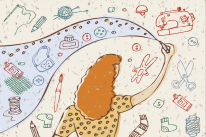
EDITOR’S NOTE: You can find a number of helpful coronavirus resources and all related Tiny Buddha articles here.
When I decided over two years ago to become a Buddhist Chaplain, I could’ve never dreamed that I would be experiencing our current pandemic crisis.
I chose to become a Buddhist Chaplain after I lost my son in 2010. The experience of losing a child forever changed how I related to the world and how I relate to grief, suffering, and compassion.
One of the most profound lessons I learned about grief is that it doesn’t have to follow the loss of a loved one. We grieve anything we feel a connected to that provides our lives with purpose and meaning. By this definition it is no wonder our current situation of isolation is creating an undercurrent of deep grief and loss for what we once deemed our “normal life.”
For two years I studied Buddhist Philosophy at Upaya Zen Center under the instruction of Roshi Joan Halifax and other incredible Buddhist teachers. Currently I’m finishing my 1600 hours of Clinical Pastoral Education (CPE) to become a board certified chaplain.
After experiencing a life-changing event I wanted to be able to give back and, in a way, keep my son’s memory alive through this work. I imagined coming alongside people as they and their loved one experience the end of life and providing compassionate bereavement support to those who were left to mourn the person they loved and lost.
These experiences, I imagined, involved human connection and touch. Warm hand to warm hand, heart to heart. I knew that my presence wouldn’t heal the whole of it but hoped that it would provide the next brush stroke in the mandala of mean-making for these people along the journey of grief.
But in these most recent days it looks more like this: I call a dad through the safety of a phone call, no heart to heart, to tell him his young son was killed in a motorcycle accident. And when he asks if he could come to the hospital and see him, I say no and explain our COVID guidelines.
Then when he shows up to collect his son’s personal belongings, I stand in the parking lot of our emergency room, with a face mask on, six feet away, hand him the bag, and instruct him not to open the red biohazard bag for three days. It’s a COVID precaution, I tell him.
He holds the bag gently, looks at me with tears welling up in his eyes, and says, “How can we even have a funeral? No one is allowed to come.” And, with that, the tears break past the levy and rush down his cheeks.
We stand in silence until he pleads, “So I really can’t see him?”
I immediately think of how I would’ve felt if someone wouldn’t have let me see my son when he died. My heart tightens, I look away and explain the guidelines again (inside I feel like a failure as a chaplain).
If this were two months ago this interaction would plant the seeds of healing. The emotional closure of seeing his son one last time would prime the pump of healing and integration. But instead, he’s left with a red biohazard bag that he can’t open for three days.
Now that I am working full time in a level one trauma center during the COVID pandemic I can’t imagine doing this work without those years of training as a compassionate caregiver grounded in Buddhist teachings.
As the days have unfolded, and my ‘typical’ chaplain experiences are tarnished by new policies, even when the patient isn’t a COVID patient, I have reflected on what teachings and skills have helped me the most. My hope is by sharing these with you it will give you some tools to come alongside others, warm hand to warm hand, heart to heart.
Allow all the feelings and emotions that arise.
This is a time of unprecedented and volatile changes. It is normal and natural that with these changes a variety of feelings arise. Unfortunately, we live in a culture that embraces toxic positivity. Seeing bumper stickers that read “good vibes only” and being encouraged to manifest the life we want through positive affirmations, we begin to feel guilty or like there is something wrong with us when we have a normal human emotion like grief, anger, or sadness.
Subconsciously withholding permission to experience the full spectrum of human emotions is akin to only allowing a pendulum to swing in one direction.
The end result is that we can only feel the positive emotions to the depth and degree that we allow ourselves to feel deeply into the difficult emotions. Any joy or happiness we experience is blunted and/or limited by our inability to lean into the difficult emotions we have as part of the human experience.
Just like any skill we develop, it takes practice. So, when we spend energy pushing away or ignoring grief, sadness, anger, or depression, we are stealing an opportunity from ourselves to become more skilled at working with this emotion.
This is one reason why many people don’t understand why they aren’t happier in spite of working hard at “good vibes only.” On the other hand, when we get to know the full spectrum of emotions, we become more agile at working with them.
For example, I know that when I’m feeling grief it often shows up in my chest, whereas anger I’m more likely to feel in my throat. I can only discern this because I work to develop a mindfulness and awareness of these.
One of the best ways to begin a relationship with the more difficult emotions that arise is to distinguish between you and the feeling.
Dr. Susan David, in her TED talk on emotional agility, suggested we shift our word choice. For example, instead of saying, “I’m sad,” try saying, “I’m feeling sad.” There are no good/bad feelings, just feelings that need to be acknowledged.
Make friends with impermanence.
Illness, old age, and death are always part of our lives, but now we feel as if they have moved in closer. The latent awareness of these inevitabilities can cause us to feel an increase in anxiety.
In part because of our cultural aversion to grief, we often live our lives as if illness, old age, and death are as far away as the moon, needing a telescope to see the details. But the truth is aging is a gift, and every morning we wake we are one day closer to all three of these.
All of our experiences are impermanent… including this one with the COVID virus! The flow of life continues even through the hurt and pain of health problems, lost jobs, and all the other difficulties that are arising in this time.
These experiences are never as far off as the moon, they are always near to us. But, just like only embracing selective emotions, when we ignore the truth of life (and death) we are likely to be caught very unprepared for when things change.
All of life, our possessions, and our relationship are temporary. Making friends with impermanence helps us suffer less, and acknowledging impermanence encourages gratitude for all that is good in this moment.
One of my favorite teachings on impermanence is by the renowned teacher Thich Nhat Hahn. They are called The Five Remembrances.
My first experience with these was in a weekend course with Frank Osteseski, the founder of the Zen Hospice Project, and Metta Institute in San Francisco.
In a very powerful group experience, we had to speak the five remembrances over and over again to one another. There wasn’t a dry eye in the group!
I’ve shared them below and I would encourage you to sit with someone you trust and say them to one another. After each statement sit with what comes up for you and feel into what you’re experiencing, not turning away from any of it.
I am of the nature to grow old. There is no way to escape growing old.
I am of the nature to have ill health. There is no way to escape ill health.
I am of the nature to die. There is no way to escape death.
All that is dear to me and everyone I love are of the nature to change. There is no way to escape being separated from them.
My actions are my only true belongings. I cannot escape the consequences of my actions. My actions are the ground upon which I stand.
Reduce your stress and increase your joy and compassion with these four Buddhist virtues.
Alleviating suffering is at the core of all Buddhist teachings. More than any other Buddhist teachings, I’ve used these four qualities to regulate the emotional turmoil and difficult times while working in the hospital.
In Buddhism you will often hear these qualities called the “Four Boundless Abodes,” or “Four Brahma Viharas.” They are loving-kindness, compassion, sympathetic joy, and equanimity.
These qualities are the ultimate form of self-care and connect us to the innate goodness within ourselves and others. I believe it is the element of connecting us to others that make these so powerful, especially during these times of social isolation.
Loving kindness, the first quality, encourages us to always make the kindest choice. This means in our own inner narrative about ourselves and in the way we interact with other people.
Practicing loving-kindness to myself could mean being mindful of my own limitations and not beating myself up if I fall short. Another way of saying this is to make sure that we are treating ourselves with the same kindness we would offer someone we love.
As we interact with others it helps to assume everyone is doing the best they can with the skills and resources they have. This doesn’t mean we agree with their actions, but it reduces our suffering by allowing us to let go of what we think should happen and express kindness. Loving-kindness is cultivated in relationship to self and others.
The second quality of the Four Boundless Abodes is compassion. Compassion arises when we stay open to the suffering of another and begin to blur the lines of being separate from others.
Compassion encourages us to not turn away from suffering, but to lean into it. This is another way that practicing with all of our emotions allows us to be fuller, more tenderhearted human beings. Compassion is the nudge we need to take action that might reduce another person’s suffering.
Compassion, like loving-kindness, is rooted in relationship with others. But it’s important to recognize we can be compassionate to another person without taking on their suffering. Sometimes just being seen in our suffering is enough to transform it.
As a chaplain I often say that all I do is listen. People want their story to be heard and their suffering to be acknowledged. In this way, by simply being present, we give the invaluable gift of being seen.
The third quality, I believe, has the most potential to transform our relationship with others and to break down barriers that keep us from suffering alone. Sympathetic joy is the practice of feeling happy for other people’s joys and happiness.
In our culture that is focused on competition and winning at all cost, this can be a very difficult thing to do. Judgment, envy, comparison, greed, and many other things get in the way of experiencing sympathetic joy. However, sympathetic joy encourages us to transform those ugly feelings into the realization that our own happiness often depends on the joy and happiness of many other people.
Gratitude is a close cousin to sympathetic joy. Finding joy in ourselves and others is another way of expressing gratitude for how things are in the current moment. It also raises the awareness of goodness in the moment when sometimes we can’t find anything good about the current situation.
Last month experienced a moment of sympathetic joy when talking to a mental health provider in our emergency room. She told a story of a very difficult bi-polar patient that, in the end, told the nurse how grateful she was for her help. Seeing the joy on the nurse’s face as she told the story cultivated joy in my heart as I thought of how good it feels to be acknowledged for the work we do that is difficult and often unrewarding.
The last quality, equanimity, pulls everything together. It holds the best of all the other qualities
Equanimity is working with our heart-mind to create a calm, unbiased mind that can hold compassion, loving-kindness, and sympathetic joy, without getting swept up in toxic positivity, or not being able to let go when it’s time.
Equanimity grounds us in an open heart that isn’t attached to how things should be, but can accept things for how they are. My teacher Roshi Joan Halifax refers to this as having a firm-back and soft-front. She also says, often jokingly, that the current agenda is subject to reality.
These are hard times, and it’s important to give yourself permission to feel all the emotions freely and fully so that you can widen the swing of the pendulum of emotions.
And with the support of sympathetic joy, joy becomes more fulfilling. With compassion and loving-kindness, we can bring in the reality of impermanence and focus on the things that really matter because we haven’t pushed them off thinking we have more time or it won’t happen to us.
Below I’ve shared a few meditations on each of the four Boundless Abodes to use as you cultivate these qualities in your own life during this difficult time.
Loving-Kindness: May I accept all my emotions with an open my heart, knowing I am not limited by them.
May I be filled with love and kindness equally towards myself and others.
Compassion: May I, and all beings, be free from suffering.
May I realize the truth of impermanence for myself and all beings.
Sympathetic Joy: May I feel your joy as my own and my joy extend to all beings.
May I find peace and well-being so that I may be of service to others.
Equanimity: May I accept all things as they are with an open heart and mind free of judgment.
May I be able to let go of expectations and accept things as they unfold.
About Paula Stephens
Paula Stephens, M.A. is a speaker, author, yogi and the founder of Crazy Good Grief. She is studying to become endorsed as a Buddhist Chaplain and currently works as a volunteer chaplain and yoga teacher at a jail near her home in Denver, Colorado. She is also a hospice chaplain, wellness coach, and ERYT Yoga Instructor.













 Though I run this site, it is not mine. It's ours. It's not about me. It's about us. Your stories and your wisdom are just as meaningful as mine.
Though I run this site, it is not mine. It's ours. It's not about me. It's about us. Your stories and your wisdom are just as meaningful as mine. 